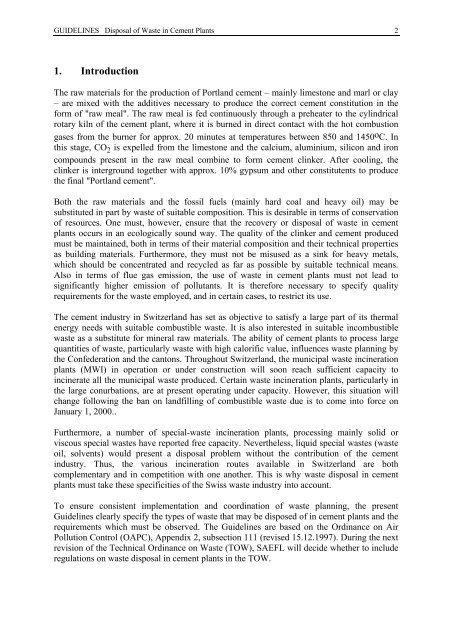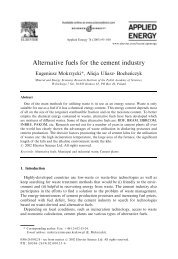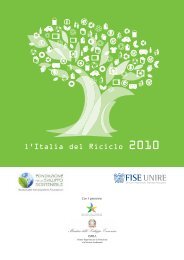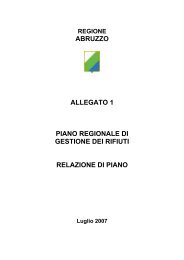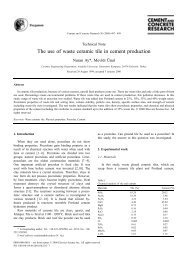GUIDELINES Disposal of Wastes in Cement Plants - BAFU
GUIDELINES Disposal of Wastes in Cement Plants - BAFU
GUIDELINES Disposal of Wastes in Cement Plants - BAFU
Create successful ePaper yourself
Turn your PDF publications into a flip-book with our unique Google optimized e-Paper software.
<strong>GUIDELINES</strong> <strong>Disposal</strong> <strong>of</strong> Waste <strong>in</strong> <strong>Cement</strong> <strong>Plants</strong> 2<br />
1. Introduction<br />
The raw materials for the production <strong>of</strong> Portland cement – ma<strong>in</strong>ly limestone and marl or clay<br />
– are mixed with the additives necessary to produce the correct cement constitution <strong>in</strong> the<br />
form <strong>of</strong> "raw meal". The raw meal is fed cont<strong>in</strong>uously through a preheater to the cyl<strong>in</strong>drical<br />
rotary kiln <strong>of</strong> the cement plant, where it is burned <strong>in</strong> direct contact with the hot combustion<br />
gases from the burner for approx. 20 m<strong>in</strong>utes at temperatures between 850 and 1450 o C. In<br />
this stage, CO 2 is expelled from the limestone and the calcium, alum<strong>in</strong>ium, silicon and iron<br />
compounds present <strong>in</strong> the raw meal comb<strong>in</strong>e to form cement cl<strong>in</strong>ker. After cool<strong>in</strong>g, the<br />
cl<strong>in</strong>ker is <strong>in</strong>terground together with approx. 10% gypsum and other constitutents to produce<br />
the f<strong>in</strong>al "Portland cement".<br />
Both the raw materials and the fossil fuels (ma<strong>in</strong>ly hard coal and heavy oil) may be<br />
substituted <strong>in</strong> part by waste <strong>of</strong> suitable composition. This is desirable <strong>in</strong> terms <strong>of</strong> conservation<br />
<strong>of</strong> resources. One must, however, ensure that the recovery or disposal <strong>of</strong> waste <strong>in</strong> cement<br />
plants occurs <strong>in</strong> an ecologically sound way. The quality <strong>of</strong> the cl<strong>in</strong>ker and cement produced<br />
must be ma<strong>in</strong>ta<strong>in</strong>ed, both <strong>in</strong> terms <strong>of</strong> their material composition and their technical properties<br />
as build<strong>in</strong>g materials. Furthermore, they must not be misused as a s<strong>in</strong>k for heavy metals,<br />
which should be concentrated and recycled as far as possible by suitable technical means.<br />
Also <strong>in</strong> terms <strong>of</strong> flue gas emission, the use <strong>of</strong> waste <strong>in</strong> cement plants must not lead to<br />
significantly higher emission <strong>of</strong> pollutants. It is therefore necessary to specify quality<br />
requirements for the waste employed, and <strong>in</strong> certa<strong>in</strong> cases, to restrict its use.<br />
The cement <strong>in</strong>dustry <strong>in</strong> Switzerland has set as objective to satisfy a large part <strong>of</strong> its thermal<br />
energy needs with suitable combustible waste. It is also <strong>in</strong>terested <strong>in</strong> suitable <strong>in</strong>combustible<br />
waste as a substitute for m<strong>in</strong>eral raw materials. The ability <strong>of</strong> cement plants to process large<br />
quantities <strong>of</strong> waste, particularly waste with high calorific value, <strong>in</strong>fluences waste plann<strong>in</strong>g by<br />
the Confederation and the cantons. Throughout Switzerland, the municipal waste <strong>in</strong>c<strong>in</strong>eration<br />
plants (MWI) <strong>in</strong> operation or under construction will soon reach sufficient capacity to<br />
<strong>in</strong>c<strong>in</strong>erate all the municipal waste produced. Certa<strong>in</strong> waste <strong>in</strong>c<strong>in</strong>eration plants, particularly <strong>in</strong><br />
the large conurbations, are at present operat<strong>in</strong>g under capacity. However, this situation will<br />
change follow<strong>in</strong>g the ban on landfill<strong>in</strong>g <strong>of</strong> combustible waste due is to come <strong>in</strong>to force on<br />
January 1, 2000..<br />
Furthermore, a number <strong>of</strong> special-waste <strong>in</strong>c<strong>in</strong>eration plants, process<strong>in</strong>g ma<strong>in</strong>ly solid or<br />
viscous special wastes have reported free capacity. Nevertheless, liquid special wastes (waste<br />
oil, solvents) would present a disposal problem without the contribution <strong>of</strong> the cement<br />
<strong>in</strong>dustry. Thus, the various <strong>in</strong>c<strong>in</strong>eration routes available <strong>in</strong> Switzerland are both<br />
complementary and <strong>in</strong> competition with one another. This is why waste disposal <strong>in</strong> cement<br />
plants must take these specificities <strong>of</strong> the Swiss waste <strong>in</strong>dustry <strong>in</strong>to account.<br />
To ensure consistent implementation and coord<strong>in</strong>ation <strong>of</strong> waste plann<strong>in</strong>g, the present<br />
Guidel<strong>in</strong>es clearly specify the types <strong>of</strong> waste that may be disposed <strong>of</strong> <strong>in</strong> cement plants and the<br />
requirements which must be observed. The Guidel<strong>in</strong>es are based on the Ord<strong>in</strong>ance on Air<br />
Pollution Control (OAPC), Appendix 2, subsection 111 (revised 15.12.1997). Dur<strong>in</strong>g the next<br />
revision <strong>of</strong> the Technical Ord<strong>in</strong>ance on Waste (TOW), SAEFL will decide whether to <strong>in</strong>clude<br />
regulations on waste disposal <strong>in</strong> cement plants <strong>in</strong> the TOW.


